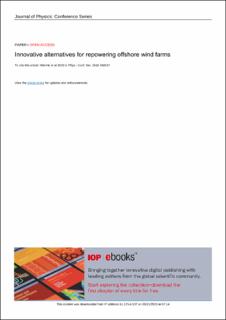| dc.contributor.author | He, Wei | |
| dc.contributor.author | Grant, Richard John | |
| dc.contributor.author | Baden, Victoria | |
| dc.contributor.author | Suntharalingam, Jarani | |
| dc.date.accessioned | 2020-12-02T11:35:27Z | |
| dc.date.available | 2020-12-02T11:35:27Z | |
| dc.date.created | 2020-09-23T12:33:44Z | |
| dc.date.issued | 2020 | |
| dc.identifier.citation | He, W., Grant, R. J., Baden, V., & Suntharalingam, J. (2020). Innovative alternatives for repowering offshore wind farms. Journal of Physics: Conference Series, 1618, 042037. | en_US |
| dc.identifier.issn | 1742-6588 | |
| dc.identifier.uri | https://hdl.handle.net/11250/2711429 | |
| dc.description.abstract | To deliver a climate neutral Europe by 2050 there is an unprecedented urgency to decarbonise Europe’s electricity supply. The offshore wind industry is gearing up to this challenge with an increase in the rate at which high generating capacity offshore wind farms (OWFs) are deployed. Innovative repowering integrates early decommissioning and repowering of OWFs by using future large wind turbines (WTs, e.g. 20 MW WT). First-of-its-kind case studies have been presented to quantify the increased power generation capacity and the levelized cost of energy (LCOE) of repowering two OWFs with fixed and floating foundations. The repowering alternatives have been compared with the base case scenario (which involves decommissioning after the design life of 20 years) and the lifetime extension scenario (decommissioning in 25th year). The case studies show that a significant increase in energy output could be coupled with a reduction in the LCOE using the same OWF sites. The capacities of the OWF with fixed and floating foundations have been increased by 2.5 times (317 MW to 800 MW) and 2 times (400 MW to 800 MW) by repowering, respectively. Compared with developing an OWF on a new site, repowering has the potential to significantly accelerate the current installation capacity. Repowering has the potential to provide a competitive alternative to the lifetime extension of OWFs. Furthermore, the OWF with floating foundations has greater LCOE reductions compared with the OWFs with fixed foundations. This study has also provided evidence that enabling technologies and collaboration with other sectors would reduce the environmental impacts and costs of decommissioning of OWFs. This paper has suggested a way forward for research and development to overcome both technological and non-technological barriers to unlock the potential benefits of innovative alternatives of repowering OWFs. | en_US |
| dc.language.iso | eng | en_US |
| dc.publisher | IOP Publishing Ltd. | en_US |
| dc.rights | Navngivelse 4.0 Internasjonal | * |
| dc.rights.uri | http://creativecommons.org/licenses/by/4.0/deed.no | * |
| dc.subject | offshore wind farm | en_US |
| dc.subject | decommissioning | en_US |
| dc.subject | repowering | en_US |
| dc.subject | levelised cost of energy | en_US |
| dc.subject | reuse | en_US |
| dc.subject | fixed foundation | en_US |
| dc.subject | floating foundation | en_US |
| dc.title | Innovative alternatives for repowering offshore wind farms | en_US |
| dc.type | Peer reviewed | en_US |
| dc.type | Journal article | en_US |
| dc.description.version | publishedVersion | en_US |
| dc.subject.nsi | VDP::Teknologi: 500::Miljøteknologi: 610 | en_US |
| dc.source.pagenumber | 11 | en_US |
| dc.source.journal | Journal of Physics: Conference Series | en_US |
| dc.identifier.doi | 10.1088/1742-6596/1618/4/042037 | |
| dc.identifier.cristin | 1832496 | |
| cristin.ispublished | true | |
| cristin.fulltext | original | |
| cristin.qualitycode | 1 | |

